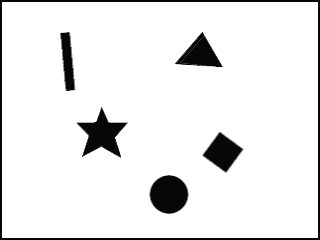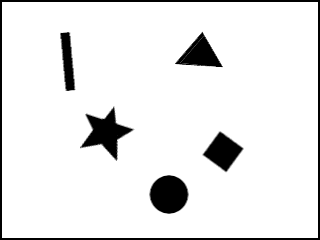Module 12 - Staging & Appeal
Appeal in a cartoon character corresponds to what would be called charisma in an actor. A character who is appealing is not necessarily sympathetic – villains or monsters can also be appealing – the important thing is that the viewer feels the character is real and interesting. There are several tricks for making a character connect better with the audience; for likable characters a symmetrical or particularly baby-like face tends to be effective. A complicated or hard to read face will lack appeal, it may more accurately be described as 'captivation' in the composition of the pose, or the character design.
Staging
Staging is the presentation of an idea so that it is completely and unmistakably clear. In the case of animation this means that everything in the shot should support the main point of the shot whether it is moving or still. In the greater film processes this means that the placement of objects in the scene including characters as well as the colors, lighting and speed.
Readability
Focusing animation alone an action is staged so that it is understood. To ensure the idea is staged clearly the eye must be led to exactly where it needs to be at the right moment. It is important to remember that only one idea can be seen by the audience at a time.
Here is an example where there is a lot of action happening. While distracting, the audiences eye will be drawn to the object that is at rest
 Click on the image to view full screen
Click on the image to view full screen
Now in this example all of the objects except one are still so our eye is drawn to the object that is moving.
 Click on the image to view full screen
Click on the image to view full screen
The important thing here is that contrasting motion will help direct the audiences eyes so make sure you are purposely directing their eye to the most important thing in the shot. This can be easier to understand when talking about separate characters or background objects, but the same thing goes for different parts of a single character. If the most important thing in the shot is we see the face go through an emotional shift from anger to regret then the characters arms shouldn't be flailing about as it will likely distract the audience away from the face and thus cause them to miss the critical characterization shift.
Look at this clip from Kung Fu Panda to see the interactions between Shifu and Oogway and how your eye is drawn between each character throughout their conversation.
Posing
An extension of our discussion of arcs from week 7 as well as our discussion about the dangers of twinning in week 8 there are natural arcs and flow our characters should be posed in within the shot to increase appeal and ensure readability.
Arcs should also be present in the basic posing of your character. If your character is moving those arcs should remain or reflect as the character moves to ensure a nice fluid balance in throughout the scene.
Check out these images
Contrapasto
Contrapposto is seen when the characters shoulders and hips have opposing angles. This gives a sense of balance and relaxation as well as strong character sense.

This is the natural position we see almost all people in. Usually when we see the shoulders and hips parallel to each other, the character feels off balance or stiff. Or both!
Working to keep contraposto in your poses will also help to ensure that there is a more natural curve to your spine.

Posing Continued
Posing is communication. In a pose we can see how a character feels, and how they are thinking.

This is a photo of a happy man. There are some tell tale signs that communicate to us that he is happy. You might immediately think that, because he is smiling, he is happy, or excited. But many of the other parts of the body also tell us he is excited. For example, we can see that he is jumping off the ground, his arms are outstretched, his head is tilted slightly towards his shoulder.
To analyze it further, let's simplify things down to a silhouette.

Now we can see all the elements that make the pose feel excited very clearly. This is why you will hear many times over that keeping a strong silhouette can help to communicate your characters emotions.
Here is another example. What do you think this character is feeling:

This one is slightly harder to read, but since we see the character leaning over, with an arm pressed into their back, most would say that the character is sad, or tired. The head is also leaning back making the pose feel extra droopy, and downtrodden.
Here is another example:

I would say that this character is frustrated. Their hands grabbing the hair like they are. The posture bent over, the uncomfortable looking leg positions all make you feel like this character just lost a bet at the horse track!
When creating poses, think very strongly about what emotion your character is trying to convey. How can you communicate that emotion as clearly and simply as possible in the pose? Look at the silhouette of your character to see how the pose is reading.
Don't take just my word for it though. Take a look at these awesome viewpoints from Disney animator Andreas Deja.
Andreas Deja was a Supervising Animator at Disney Feature Animation for 30 years. He helped to create the performances of many of the Disney characters that you know today.
On Silhouette: http://andreasdeja.blogspot.com/2011/08/strong-silhouetteor-not.html
On Staging: http://andreasdeja.blogspot.com/2011/08/disney-staging.html
Appeal
The common definition of something being appealing or not is whether the thing being described is positive. However, in animation and film-making in general even evil characters need to have appeal. Appeal in this sense is more than just positive or negative it is the entire package of believability, likability and empathy as well as how they fit within the story. I Often feel like the bad guy is the most interesting character in a film.
We could go on forever talking about character appeal, but your intuitions will give you a lot more information through observation than exposition. Let's look at some clips to 'observe' the appeal
Kung Fu Panda 2 - Lord Shen
Ratatouille - Anton Ego
Batman The Dark Knight - The Joker
Rango - Rattlesnake Jake
Of course the bad guys aren't always the most appealing. Let's take a look at some of the lighter side of appeal.
Tangled - Maximus
Wreck it Ralph - Vanellope
LEGO Movie - Emmet
Notice how every action and pose in these shots draws us into the scene. The characterization is solid throughout to help us continue through the story. Definitely appealing right? :)
Assignment
3 Emotion Poses (Blik)
This week we are going to be taking a short break from actual animation to focus once again on creating strong poses.
Once again we will be using the Blik rig and you are going to create 3 different poses each one representing a different strong emotion.
Make sure you use strong arcs in your posing and ensure the silhouette is just as readable for the emotion as it is when fully shaded.
Once complete submit your assignment in UNM Canvas
-
Class Lecture
Attend Class Lecture -
Class Instruction
Participate in class discussions and assignment -
Discussion
Staging and Appeal -
Lab & Exercises







